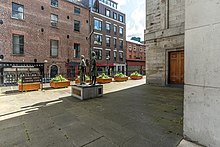 | |
| Native name | Sráid na hArdeaglaise (Irish) |
|---|---|
| Former name(s) | Elephant Lane, Tyrone Place |
| Namesake | St Mary's Pro-Cathedral |
| Type | Street |
| Length | 130 m (430 ft) |
| Location | Dublin, Ireland |
| Postal code | D01 |
| Coordinates | 53°21′02″N 6°15′34″W / 53.3505376°N 6.25936366°W |
| West end | O'Connell Street |
| East end | Marlborough Street |
Cathedral Street is a street in central Dublin, Ireland, formerly known as Elephant Lane and Tyrone Place.
Location
[edit]
Cathedral Street runs from O'Connell Street Upper to Marlborough Street. St Mary's Pro-Cathedral sits on the corner of Cathedral and Marlborough Streets.[1]
History
[edit]On 18th century maps of Dublin, this street is named Elephant Lane. McCready attributes this to a corruption of Mellifont Lane, Menagerie Lane, or due to the presence of a tavern on the street with a sign featuring an elephant.[2] According to the 1850 New City Pictorial Directory, besides four vacant buildings, Elephant Lane's occupants included, a plumber, locksmith, job coach establishment, an ivory turner, two booksellers and two vintners.[3] The street was later known as Tyrone Place from 1870 due to it leading to Tyrone House,[4] and was renamed Cathedral Street in 1900.[5]
The Post Office Tavern was at No. 9 Elephant Lane and from 1854 run by a James Kenny until 1870 when he is the hotel and tavern keeper of the Post Office Hotel now noted to be in Tyrone Place. John Nagle is the proprietor of the establishment in 1875.[6]
The historic house, Drogheda House, since demolished was on the corner of Cathedral Street and O'Connell Street, and dated from 1751. The eastern side of Cathedral Street survived the destruction of the Easter Rising in 1916 but was later destroyed during the Civil War in 1922.[7]
Plans to refurbish Cathedral Street with Sackville Place to facilitate better pedestrian access between the Luas lines were scrapped in 2018.[8]
See also
[edit]References
[edit]- ^ "Saint Mary's Pro-Cathedral, Marlborough Street, Cathedral Street, Dublin 1, DUBLIN". Buildings of Ireland. Retrieved 7 March 2021.
- ^ M'Cready, C. T. (1987). Dublin street names dated and explained. Blackrock, Co. Dublin: Carraig. p. 34. ISBN 1850680000.
- ^ Shaw, Hanry (1850). New City Pictorial Directory 1850, (reprint 1988). Dublin: Henry Shaw. ISBN 0-946872-11-2.
- ^ Cosgrave, Augustine Dillon (1969). "North Dublin City". Dublin Historical Record. 23 (1). Dublin: Old Dublin Society: 21. ISSN 0012-6861. JSTOR 30082548. Retrieved 8 March 2021.
- ^ "8. Elephant Lane and co". Come Here To Me!. 12 November 2011. Retrieved 7 March 2021.
- ^ French, E.J. (31 December 1981). "Tavern Tokens". The Journal of the Royal Society of Antiquaries of Ireland. 8 (2). Dublin: Royal Society of Antiquaries of Ireland: 167, 169. ISSN 0035-9106. JSTOR 25549752. Retrieved 8 March 2021.
- ^ Casey, Christine (2005). Dublin : the city within the Grand and Royal Canals and the Circular Road with the Phoenix Park. New Haven, Conn.: Yale University Press. pp. 213, 214. ISBN 9780300109238.
- ^ Kelly, Olivia (14 May 2018). "Councillors axe plans to upgrade Dublin streets". The Irish Times. Retrieved 7 March 2021.
